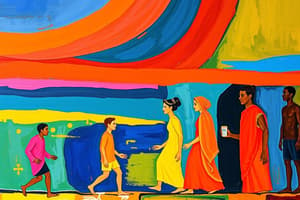Podcast
Questions and Answers
What does the Davis-Moore Thesis state?
What does the Davis-Moore Thesis state?
- The more society values a particular profession, the more the people in that profession will make. (correct)
- The less society values a particular profession, the more opportunities are available.
- The value of a profession is determined by societal needs.
- The more society values a particular profession, the higher the status of the people in that profession.
According to the author, their ______________ increase by virtue of their being able to shift residence from a caste to a class society.
According to the author, their ______________ increase by virtue of their being able to shift residence from a caste to a class society.
life chances
What does Mohit's situation illustrate?
What does Mohit's situation illustrate?
A caste system
What is a main issue in studying global social inequality?
What is a main issue in studying global social inequality?
___________________ is research of mobility within a generation.
___________________ is research of mobility within a generation.
What is conspicuous consumption?
What is conspicuous consumption?
What is particularly unique about the United States middle class?
What is particularly unique about the United States middle class?
The socio-economic layering of society's members according to property, power, and prestige is called __________________.
The socio-economic layering of society's members according to property, power, and prestige is called __________________.
_______________________ is research of mobility between generations (e.g., grandparents to parents to grandchildren to great-grandchildren).
_______________________ is research of mobility between generations (e.g., grandparents to parents to grandchildren to great-grandchildren).
Max Weber said __________ are access to basic opportunities and resources in the marketplace.
Max Weber said __________ are access to basic opportunities and resources in the marketplace.
Flashcards are hidden until you start studying
Study Notes
Social Inequality and Mobility
- The Davis-Moore Thesis posits that professions valued by society yield higher earnings for individuals within those roles.
- Life chances refer to opportunities available to individuals based on their social and economic status, highlighted by the experiences of Indian migrants in the U.S. transitioning from caste to class society.
Caste System and Social Mobility
- Mohit's experience in Mumbai exemplifies life under a caste system, where acceptance of one’s lower-class status is influenced by witnessing the failures of others who attempted social mobility.
- Intra-generational mobility studies how individuals move within their social class during their lifetime.
- Inter-generational mobility examines movement across social classes through generations, analyzing shifts from grandparents to grandchildren.
Purchasing Behavior and Social Classes
- Conspicuous consumption describes the act of purchasing luxury items, like a $5,000 designer purse, to display social status and desirability.
- The U.S. middle class is distinctively categorized into upper and lower middle classes, indicating further stratification within this economic group.
Understanding Social Stratification
- Social stratification defines the hierarchical layering of individuals based on property, power, and prestige, forming the foundation of societal inequalities.
- The complexity of global social inequality arises from its relative nature, making cross-cultural comparisons challenging.
Access to Resources
- Max Weber characterized life chances as the access individuals have to essential opportunities and resources in the societal marketplace, emphasizing the role of social context in shaping personal success.
Studying That Suits You
Use AI to generate personalized quizzes and flashcards to suit your learning preferences.




